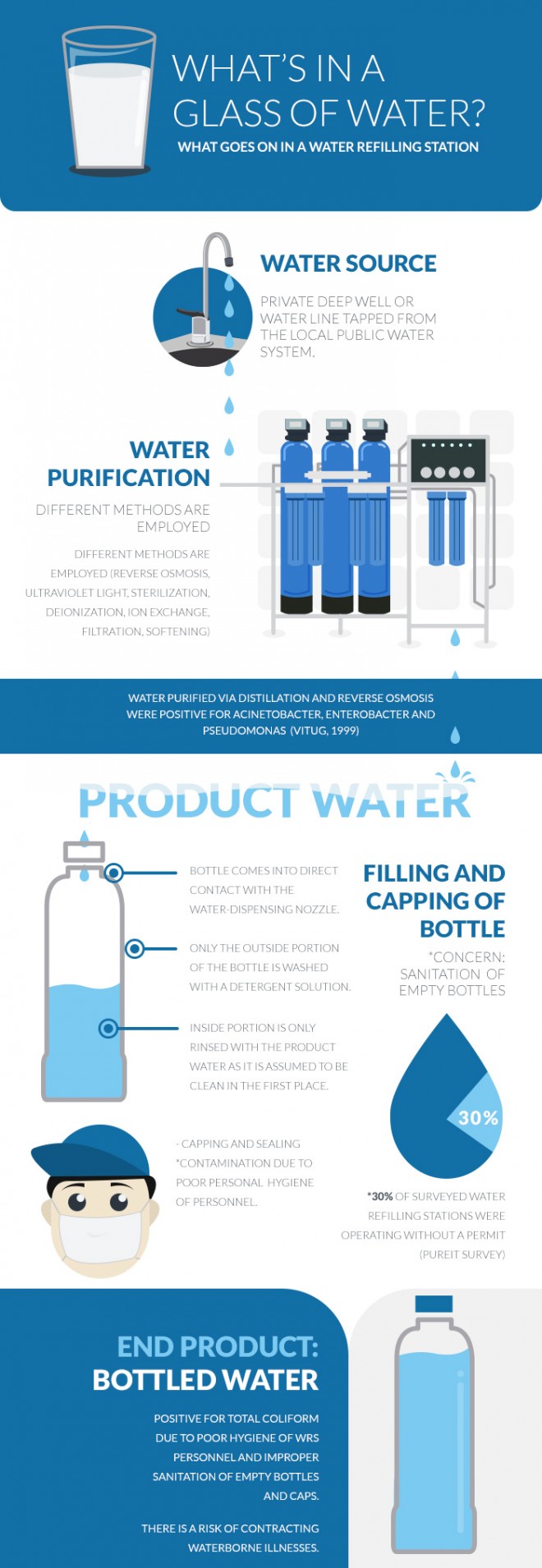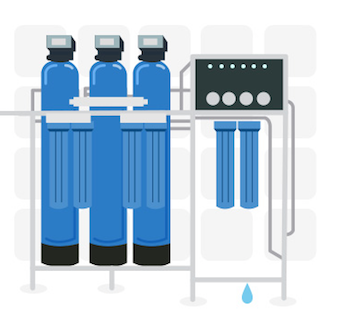![]()
Nikki* woke up crying with a sharp pain in her abdomen. The next few days, her health deteriorated even more as she experienced bloody diarrhea, nausea, loss of appetite and fever. A trip to the doctor confirmed that she had amoebiasis, a type of stomach flu caused by a parasite. In more serious cases, this disease could even spread to the liver, lungs and the brain. The surprising culprit behind this illness? Water refills from refilling stations that do not meet high quality standards for potable drinking water.
Drinking water is essential to our survival and health. However, we should always be wary of the impurities and waterborne diseases present in it. When left unchecked, our drinking water could contain salmonella, cholera, e. coli and the Entamoeba histolytica, as was the case with Nikki.
To prevent contamination, water goes through treatment methods like reverse osmosis and deionization.
Surprising statistics on non-compliance by water stations
Although the different methods of purification remove bacteria found in water, we should also take into account how it is handled and where it passes through.

A 2013 study** showed that almost 80% of surveyed water refilling stations do not comply with Presidential Decree 856, the Code on Sanitation of the Philippines. The main reason behind this is failure to present an updated sanitary permit. Furthermore, an objective written exam was used to assess the workers’ knowledge on water sanitation in the context of a water refilling station. Exam results indicated that the respondents performed poorly on water sampling, the act of collecting water samples to be submitted to DOH-accredited laboratories and promotion of water sanitation and safety.
This is supported by a survey conducted by Pureit. A whopping 80% of the 313 surveyed water refilling stations do not implement the safety measures required to prevent water contamination via physical contact. Out of the 313 water refilling stations, 257 have no face masks, 264 have no scrub suits, 266 have no hair net and an alarming 301 have no gloves!
The same survey concludes that 35% of the water refilling stations fail to implement the correct procedure for sanitizing the water containers prior to refilling of drinking water. It comes as no surprise, then, that a lot of these stations operate without a sanitary permit or mandate set by the DOH.
With these numbers brought to light, it is now up to the Filipino households to equip themselves with additional cautionary measures and extra protection against water contamination.
Safe enough isn’t good enough
In this day and age, households should invest in a clean, reliable and safer source of drinking water.
According to the World Health Organization (WHO), “improvements in drinking water quality appear to be of significant benefit to health when improvement is secured close to the point of use – that is in the household.” (World Health Organization, 2008). Another WHO study, this one on the reduction of diarrhea in Guatemalan children***, has proven that in-home water treatment “successfully reduced diarrhea among all age groups but most importantly, it reduced it in the most vulnerable children, those < 1 year of age.” (World Health Organization, 2006).
Moreover, the United Nations Children’s Fund (UNICEF) also promotes household water treatment as an effective means of preventing waterborne disease. In fact, it is the answer to “its commitment by this year to reduce by half the people without sustainable access to safe drinking water “, one of their Millennium Development Goals.
With the use of in-home water purifiers, drinking water is directly treated right before it is consumed, thereby minimizing possible points of contamination.
Introducing the World’s Largest Selling In-Home Water Purifier
Unilever, one of the world’s largest consumer goods companies, developed Pureit, an advanced system for water purification. Pureit is now available in 14 countries and has become the world’s largest selling in-home water purifier brand. It uses breakthrough technology to provide families with safe drinking water that meets the US Environment Protection Agency’s benchmarks for microbiological safety. This is possible because Pureit uses a multi-stage purification process that removes all harmful bacteria, viruses, and parasites and eliminates metallic and chemical impurities such as rust, lead, chlorine, and pesticides.
Just because we live in a third world country doesn’t mean our water has to be third rate as well.
With Pureit you and your family are sure to enjoy purified water that’s up to the standards of developed nations. The simple task of pouring water on top of this non-electrical device and just letting it pass through its effective purification system ensures hydrating yourself with safe drinking water, anytime of the day. The use of Pureit proves to be more cost-effective in the long run as it guarantees the prevention of waterborne diseases, thereby decreasing your family’s health care expenses.
More curious than ever? Visit PureitWater.com to learn more about the science behind this incredible product.
*name changed to protect privacy
**Cope, M. B., Gutierrez, S. S., Mañalac, M. C., Ocampo, M.D.J., Perez, P. P. & Quizon, R. R. (2013). Knowledge and Practices of Water Refilling Station Owners and Operators in Providing Safe and Wholesome Drinking Water Supply in One Municipality of Cavite. Acta Medica Philippina, 47 (2), 22-29.
***Chiller, T. M., Mendoza, C. E., Lopez, B., Alvarez, M., Hoekstra, R. M., Keswick, B.H. & Luby, S. P. (2006). Reducing diarrhea in Guatemalan children: randomized controlled trial of flocculant-disinfectant for drinking- water. Bulletin of the World Health Organization, 84 (1), 28-33.







































